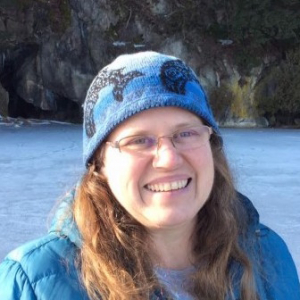On a clear, calm day in the mid-1980s, Cathy Paris scouted the Northeast Kingdom’s dark spruce-fir forest from the window of a small plane. With UVM Environmental Studies professor Ian Worley as the pilot, the focused graduate student was on the hunt for unmapped serpentine outcrops that might host the Green Mountain maidenhair fern (Adiantum viridimontanum), the species that Cathy would soon name and describe.
Meanwhile, in the small city of Burlington, Hub Vogelmann had just launched the UVM Field Naturalist Program. Unbeknownst to anyone at the time, the evolution of the FN Program and the arc of Cathy’s professional career would intertwine like two strands of DNA.
Cathy has taught Field Botany for Natural Resource Professionals—a foundational course of the program—for over 20 years. Alongside her colleague Liz Thompson, she assembled an iconic line-up of exemplary natural communities across Vermont, from the remnant sand dunes at Alburgh to the clayplain forest at Williams Woods. Under Cathy’s tutelage, generations of students have carefully noted Official Course Plants, studied indusia through their hand lenses, and successfully keyed out goldenrods. Cathy has also served on the graduate committees of around fifty Field Naturalists, advising them through completion of their master’s projects. Cathy is known for her meticulous and skilled editing, thoughtful questions, and responsiveness. She holds students to a high standard and is deeply kind and generous.
A natural teacher, Cathy speaks with an eloquent precision that leads botany students directly into the magic of the plant kingdom. The way she describes plants—a tubercle like a child’s party hat, a swamp full of nodding cottonsedge like a galaxy of stars— makes us all want to lean in and look closely, to speak the language of botany. Cathy keeps a jar of clubmoss spores close at hand, and many FNs have gathered ’round to witness her mischievous look as she pours the flammable reproductive material onto a lit match, and the spores alight in a sudden, fiery flash.

Through all the years of the Field Naturalist Program, Cathy’s generosity has extended beyond the classroom: she and Dave hosted an annual post-Field Botany celebration in their home for about 15 years in a row. As the pandemic caused shutdowns in 2020, the two superheroes even hosted Cohort AJ’s graduation in their own backyard as the wood frogs chorused on. Though she is beginning to transition away from her full-time faculty position, Cathy continues to mentor, guide, and delight us. Her own delight in plants never fades, and she approaches the natural world with a contagious joy and playfulness. This summer, another cohort of Field Naturalists will follow Cathy around with their hand lenses as she shows them a persistent calyx here, a shining stipitate gland there. She’ll be one of the first friendly faces to welcome them, and they’ll follow her up the winding Long Trail into the rich cove forest to learn how to see and describe the flora of Vermont. And long after the semester ends, Cathy will still be an anchor for the Field Naturalist Program, inviting us to marvel at plants with her and keeping the spore-fed fire burning bright.




